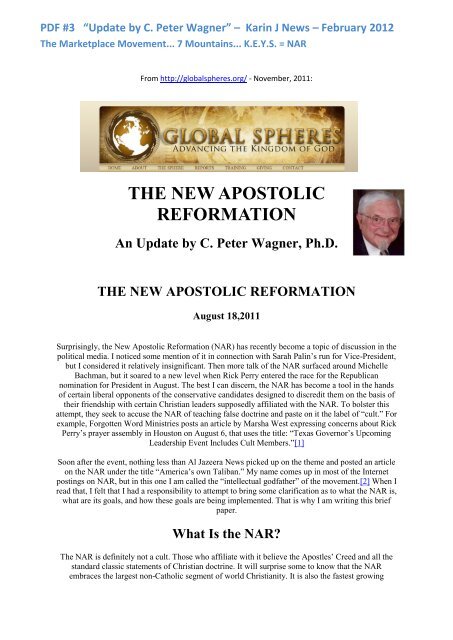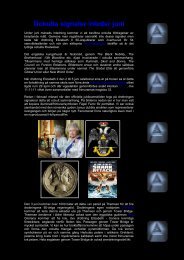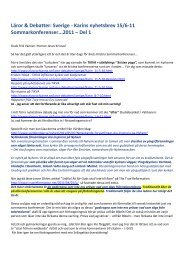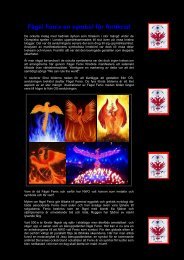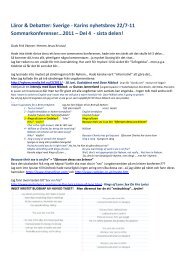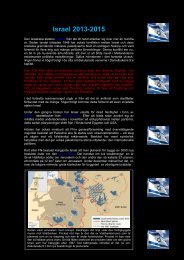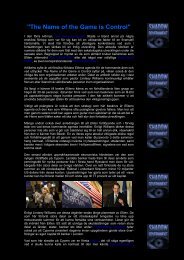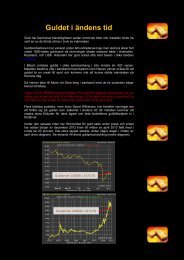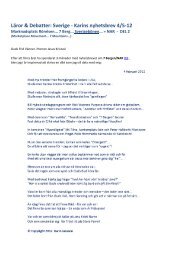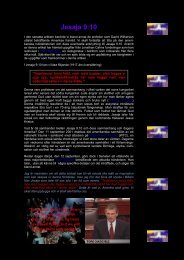THE NEW APOSTOLIC REFORMATION - Elvorochjanne.se
THE NEW APOSTOLIC REFORMATION - Elvorochjanne.se
THE NEW APOSTOLIC REFORMATION - Elvorochjanne.se
Create successful ePaper yourself
Turn your PDF publications into a flip-book with our unique Google optimized e-Paper software.
PDF #3 “Update by C. Peter Wagner” – Karin J News – February 2012The Marketplace Movement... 7 Mountains... K.E.Y.S. = NARFrom http://globalspheres.org/ - November, 2011:<strong>THE</strong> <strong>NEW</strong> <strong>APOSTOLIC</strong><strong>REFORMATION</strong>An Update by C. Peter Wagner, Ph.D.<strong>THE</strong> <strong>NEW</strong> <strong>APOSTOLIC</strong> <strong>REFORMATION</strong>August 18,2011Surprisingly, the New Apostolic Reformation (NAR) has recently become a topic of discussion in thepolitical media. I noticed some mention of it in connection with Sarah Palin’s run for Vice-President,but I considered it relatively insignificant. Then more talk of the NAR surfaced around MichelleBachman, but it soared to a new level when Rick Perry entered the race for the Republicannomination for President in August. The best I can discern, the NAR has become a tool in the handsof certain liberal opponents of the con<strong>se</strong>rvative candidates designed to discredit them on the basis oftheir friendship with certain Christian leaders suppo<strong>se</strong>dly affiliated with the NAR. To bolster thisattempt, they <strong>se</strong>ek to accu<strong>se</strong> the NAR of teaching fal<strong>se</strong> doctrine and paste on it the label of “cult.” Forexample, Forgotten Word Ministries posts an article by Marsha West expressing concerns about RickPerry’s prayer as<strong>se</strong>mbly in Houston on August 6, that u<strong>se</strong>s the title: “Texas Governor’s UpcomingLeadership Event Includes Cult Members.”[1]Soon after the event, nothing less than Al Jazeera News picked up on the theme and posted an articleon the NAR under the title “America’s own Taliban.” My name comes up in most of the Internetpostings on NAR, but in this one I am called the “intellectual godfather” of the movement.[2] When Iread that, I felt that I had a responsibility to attempt to bring some clarification as to what the NAR is,what are its goals, and how the<strong>se</strong> goals are being implemented. That is why I am writing this briefpaper.What Is the NAR?The NAR is definitely not a cult. Tho<strong>se</strong> who affiliate with it believe the Apostles’ Creed and all thestandard classic statements of Christian doctrine. It will surpri<strong>se</strong> some to know that the NARembraces the largest non-Catholic <strong>se</strong>gment of world Christianity. It is also the fastest growing
<strong>se</strong>gment, the only <strong>se</strong>gment of Christianity currently growing faster than the world population andfaster than Islam.[3] Christianity is booming now in the Global South which includes sub-SaharanAfrica, Latin America, and large parts of Asia. Most of the new churches in the Global South, evenincluding many which belong to denominations, would comfortably fit the NAR template.The NAR repre<strong>se</strong>nts the most radical change in the way of doing church since the ProtestantReformation. This is not a doctrinal change. We adhere to the major tenets of the Reformation: theauthority of Scripture, justification by faith, and the priesthood of all believers. But the quality ofchurch life, the governance of the church, the worship, the theology of prayer, the missional goals,the optimistic vision for the future, and other features, constitute quite a change from traditionalProtestantism.The NAR is not an organization. No one can join or carry a card. It has no leader. I have been calledthe “founder,” but this is not the ca<strong>se</strong>. One reason I might be <strong>se</strong>en as an “intellectual godfather” isthat I might have been the first to ob<strong>se</strong>rve the movement, give a name to it, and describe itscharacteristics as I saw them. When this began to come together through my re<strong>se</strong>arch in 1993, I wasProfessor of Church Growth at Fuller Theological Seminary, where I taught for 30 years. The roots ofthe NAR go back to the beginning of the African Independent Church Movement in 1900, theChine<strong>se</strong> Hou<strong>se</strong> Church Movement beginning in 1976, the U.S. Independent Charismatic Movementbeginning in the 1970s and the Latin American Grassroots Church Movement beginning around thesame time. I was neither the founder nor a member of any of the<strong>se</strong> movements, I was simply aprofessor who ob<strong>se</strong>rved that they were the fastest growing churches in their respective regions andthat they had a number of common characteristics.If I was going to write about this phenomenal move of the Holy Spirit, I knew I had to give it a name.I tried “Postdenominational” but soon dropped it becau<strong>se</strong> of the objections of many of my friendswho were denominational executives. Then, in 1994, I tested “New Apostolic Reformation.”“Reformation” becau<strong>se</strong> the movement matched the Protestant Reformation in world impact;“Apostolic” becau<strong>se</strong> of all the changes the most radical one was apostolic governance, which I’llexplain in due time; and “New” becau<strong>se</strong> <strong>se</strong>veral churches and denominations already carried thename “apostolic,” but they did not fit the NAR pattern. Other names of this movement which aremore or less synonymous with NAR have been “Neopentecostal,” “Neocharismatic,” “Independent,”or “Nondenominational.”I am rather fascinated at the lists of individuals whom the media glibly connects with the NAR. I’msure that some of them wouldn’t even recognize the term. In many ca<strong>se</strong>s, however, they would fit theNAR template, but since the NAR has no membership list they them<strong>se</strong>lves would need to saywhether they consider them<strong>se</strong>lves affiliated or not.For tho<strong>se</strong> who might be interested in such things, the books I have written related to NAR includeThe New Apostolic Churches (1998); Churchquake! (1999); Apostles and Prophets (2000), ChangingChurch (2004); and Apostles Today (2006). The<strong>se</strong> are all available on amazon.com.Concerns about the NARIf the critics are using openness to NAR as a slur against con<strong>se</strong>rvative political candidates, theyobviously need to verbalize what could be wrong with NAR in the first place. To suppo<strong>se</strong> that NARis a “cult” or that it teaches “heresy” can be attributed only to sloppy or immature journalism. All toooften “heresy” has come to mean only that the person disagrees with me and my friends, but thepurpo<strong>se</strong> of using the word is to project guilt by association on the politician. It attempts to implant aquestion: Who would vote for a heretic? But there is little evidence pre<strong>se</strong>nted that the issue inquestion incorporates the doctrinal unorthodoxy of a true heresy. Instead, key words are usuallydropped which describe legitimate areas of disagreement among Christian theologians on the level ofwhether or not we baptize infants. Neither of the opposite positions on matters like this de<strong>se</strong>rve to be
to have kingdom-minded people in every one of the Seven Mountains: Religion, Family, Education,Government, Media, Arts & Entertainment, and Business so that they can u<strong>se</strong> their influence to createan environment in which the blessings and prosperity of the Kingdom of God can permeate all areasof society.Extra-biblical revelation. Some object to the notion that God communicates directly with us,supposing that everything that God wanted to reveal He revealed in the Bible. This cannot be true,however, becau<strong>se</strong> there is nothing in the Bible that says it has 66 books. It actually took God a coupleof hundred years to reveal to the church which writings should be included in the Bible and whichshould not. That is extra-biblical revelation. Even so, Catholics and Protestants still disagree on thenumber. Beyond that, I believe that prayer is two way, we speak to God and expect Him to speakwith us. We can hear God’s voice. He also reveals new things to prophets as we have <strong>se</strong>en. The onemajor rule governing any new revelation from God is that it cannot contradict what has already beenwritten in the Bible. It may supplement it, however.Supernatural signs and wonders. I have a hard time understanding why some include this in theirlist of “heresies.” Whenever Jesus <strong>se</strong>nt out His disciples he told them to heal the sick and cast outdemons. Why we should expect that He has anything el<strong>se</strong> in mind for us today is puzzling. True, thisstill pulls some traditionalists out of their comfort zones, but that just goes with the territory. Onecritic claimed that the NAR has excessive fixation on Satan and demonic spirits. This is purely ajudgment call, and it may only mean that we cast out more demons than they do. So what?Relational StructuresSome of the authors I read expres<strong>se</strong>d certain frustrations becau<strong>se</strong> they found it difficult to get theirarms around the NAR. They couldn’t find a top leader or even a leadership team. There was nonewsletter. The NAR didn’t have an annual meeting. There was no printed doctrinal statement orcode of ethics. This was very different from dealing with traditional denominations. The reasonbehind this is that, whereas denominations are legal structures, the NAR is a relational structure.Everyone is related to, or aligned, with an apostle or apostles. This alignment is voluntary. There isno legal tie that binds it. In fact, some have dual alignment or multiple alignment. Apostles are not incompetition with each other, they are in cahoots. They do not <strong>se</strong>ek the best for them<strong>se</strong>lves, but fortho<strong>se</strong> who choo<strong>se</strong> to align with them. If the spotlight comes on them, they will accept it, but they donot <strong>se</strong>ek it.The key to this? The mutual and overriding desire that “Your kingdom come, Your will be done onearth as it is in heaven!”-end-[1]http://www.forgottenword.org/leadershipevent.html[2]http://english.aljazeera.net/indepth/opinion/2011/07/20117259426336524.html[3]David B. Barrett, et. al., eds., World Christian Encyclopedia,, Volume 1, Oxford UK: Oxford UniversityPress, 2001, p. 4


